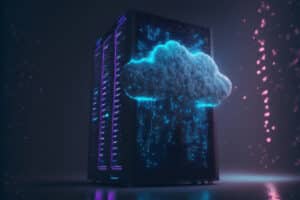While cloud modernization promises significant advantages, it also poses countless challenges, particularly in integrating legacy systems and ensuring robust cybersecurity. Both government agencies and high-compliance organizations must navigate complex issues like data integrity, user adaptation, and secure data storage.
SealingTech supports many organizations in overcoming these hurdles while adapting to the unique cybersecurity requirements during implementation and training. Here’s how.
Enabling Hybrid Cloud Models for High-Performance Use Cases

Leveraging the cloud’s ability to store data at a low cost for long periods of time reduces the complexity of designing, deploying, and maintaining on-prem storage where retention policy can exceed 25 years.
When it comes to cloud modernization, particularly in high-performance applications, SealingTech focuses on hybrid cloud models, which combine on-premises (on-prem) and cloud resources. Traditional high-performance computing environments lack the security controls necessary to process data and users from disparate security organizations. However, with the right security measures in place, separate different users can leverage shared resources without compromising data integrity. This approach helps organizations maximize the utilization of high-performance computing resources by allowing multiple users to perform operations concurrently and creates an environment in which local on-premises controls tightly align with those applied in cloud environments.
When contemplating cloud or hybrid models, it’s worth considering a range of factors to tailor the solution for your operational needs. Some organizations execute prolonged, resource-intensive computations, which tend to be cost-prohibitive to perform in the cloud. In those scenarios, it’s advisable to choose on-prem solutions for cost-intensive computational tasks while using the cloud for long-term cold storage. Leveraging the cloud’s ability to store data at a low cost for long periods of time reduces the complexity of designing, deploying, and maintaining on-prem storage where retention policy can exceed 25 years.
Strong security measures and effective data management prevent data breaches and unauthorized access while allowing approved users to share resources and track sensitive data throughout its lifecycle. That way, you can ensure that data remains accessible and associated with the correct user and program when needed. While this approach has been present in cloud infrastructures since its infancy, high-performance computing is playing catch-up, but with these security measures in place, parity with clouds is achieved and increased utilization of on-prem resources is possible. This increase in utilization is essential in realizing the cost savings of using on-prem computing for certain workloads.
An essential aspect of these security measures involves using specialized cloud environments, often referred to as “FENCES,” provided by the Department of Defense and owned and operated by major cloud service providers. FENCES is a secure, isolated cloud environment, specifically designed to meet the stringent security requirements of government and high-compliance organizations. In addition to its cost savings through design, deployment, and maintenance of infrastructure, many of the security controls are inheritable by end-user organizations reducing the expense associated with information assurance activities including accreditation processes.
Challenges in Cloud Migration for High-Performance Users
Migrating legacy systems to the cloud while maintaining security protocols presents several challenges, which vary by organization. At SealingTech, we’ve worked with communities wherein the HPC user team was not familiar with operating in environments where their interactions with compute resources were constrained; constraints which are necessary to securely share resources. The users were accustomed to unfettered, administrator-level access to the systems within the compute environment. Such access makes it impossible to achieve strong separation of sensitive data while concurrently achieving high utilization rates. Thus new controls, and new approaches to using the systems, were introduced.
Training, Documentation, and Tooling to Ease the Transition and User Adaptation
Introducing robust security measures often requires significant training and, for less security-aware users, even a cultural shift. Users need to adapt to new processes that ensure secure operations without disrupting their workflow. This involves a learning curve wherein users familiarize themselves with performing tasks in an environment that processes data on behalf of multiple entities at the same time while maintaining strict security protocols.

Introducing robust security measures often requires significant training and, for less security-aware users, even a cultural shift. Users need to adapt to new processes that ensure secure operations without disrupting their workflow.
It’s also important to recognize the hurdles introduced by stringent security measures and address them through comprehensive training and documentation. This provides users with the necessary knowledge and tools to operate securely within the new cloud environment. To minimize the impact of security protocols on user experience, SealingTech also develops tools that facilitate a smoother transition, making it easier for users to comply with security requirements. This combination of automation tools and enhanced on-premises security tools developed by SealingTech supporting strong separation of sensitive workloads enables organizations to deploy, accredit, and maintain on-premises solutions.
Key challenges in cloud migration include:
- Incorporating security measures and user experience: To avoid a scenario where users attempt to work around new protocols, you should aim to balance security controls with user convenience, ensuring a safe environment that users don’t perceive as intrusive. SealingTech’s tools focus on supporting multiple tenancy in high-performance environments allowing users across organizations to securely store, track, and process data. This is achieved through the use of a carefully designed security orchestrator responsible for tracking and confining users, data, and compute jobs within on-prem environments.
- Monitoring events for compliance: In most cases, legal or compliance requirements will determine the environment’s security architecture. Defining a roadmap that respects your legal obligations, system cost, and users’ legal and technical knowledge will let you determine a solution with long-term value.
- Continuous monitoring and real-time threat detection: SealingTech’s provisioning tools deploy monitoring systems to ensure that events get reported to a central location for swift remediation and that information assurance teams respond to potential threats quickly. Combined with the monitoring capabilities included in SealingTech’s security tools for supporting multi-tenant use of resources, SealingTech provides information assurance efforts to investigate and remediate “spillage” events or more nefarious exfiltration events.
- Integration with existing systems: Migrating to the cloud often involves integrating with existing on-prem systems. While many solutions can be seamlessly integrated, be prepared for hybrid environments to pose new challenges to security and integrity, not all of which have been resolved. SealingTech’s tools provide a layer of abstraction between users and resources allowing individuals to store, retrieve data, and process data without the need to know where or how it is stored.
Integrating High-Security On-Site Systems with Cloud Environments
One of the significant challenges in cloud modernization is integrating high-security on-prem systems with cloud environments. This involves addressing technical issues such as user reconciliation and security tagging.
- User federation: Ensuring that on-prem system users are accurately represented in cloud environments is crucial. However, the process of incorporating high-security local systems with cloud environments has yet to be sufficiently addressed with today’s technology. While highly desirable, a connection to a single system of record for user authentication and authorizations for both on-prem and cloud systems isn’t always possible. Your roadmap should account for updates to the current infrastructure as more advanced solutions are developed to remedy these issues.
-
One of the significant challenges in cloud modernization is integrating high-security on-prem systems with cloud environments.
Security tagging: Properly tagging data and applications for security purposes is essential for maintaining data integrity in cloud environments. SealingTech is actively involved in developing reference architectures and standards to address these issues, tagging users, data, or applications, depending on mission requirements.
- Multi-tenancy: For the Department of Defense, quick deployment is often critical to a mission’s success. At the same time, your system needs to account for scenarios where users may work on behalf of different tenants throughout the day or even across military bases. Further, users may still need some level of access to data between tenants throughout the day, such as the ability to read data they created in one tenant while writing data on behalf of another (a multi-level scenario).
Prepare Your Organization for the Future of Cloud and Hybrid Solutions
Exploring the complexities of cloud modernization can be challenging. At SealingTech, we understand the unique security requirements involved in this journey. Our team is dedicated to providing tailored solutions that seamlessly integrate high-security on-prem systems with cloud environments, ensuring data integrity and robust cybersecurity. Got a question? Contact SealingTech’s experts today to learn how we can support your organization in navigating cloud modernization securely and efficiently.
Related Articles
Harnessing AI for the Cyber Warfighter
When deploying junior and senior cyber operators on a mission, experience levels amongst the team will vary. At times, junior operators may have questions and need to interact with unfamiliar…
Perspectives & Post-Quantum Encryption: NATO Edge 24
In December, SealingTech Account Managers, Wade Saunders and Benjamin Young, traveled to NATO Edge 24 in Tampa, Florida—an annual forum for industry experts and peers to address current and future…
Disrupting Adversary Threats
As a Principal Solutions Architect for SealingTech and proud 20-year US Army Veteran specializing in defensive cyberspace operations, I take the threat of near-peer adversaries seriously. Near-peer adversaries are predatory…
Could your news use a jolt?
Find out what’s happening across the cyber landscape every month with The Lightning Report.
Be privy to the latest trends and evolutions, along with strategies to safeguard your government agency or enterprise from cyber threats. Subscribe now.
